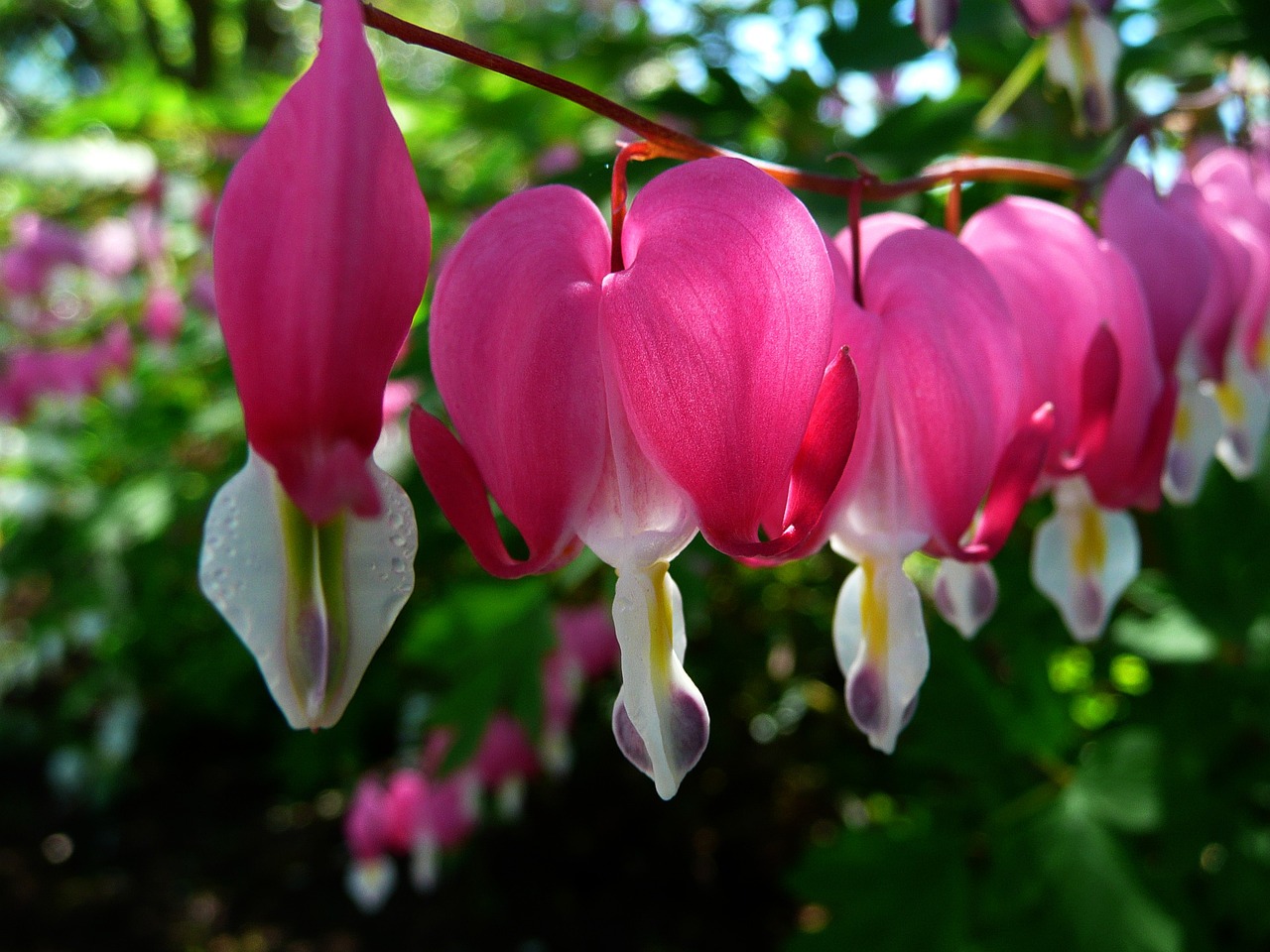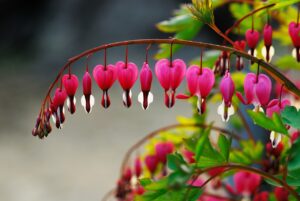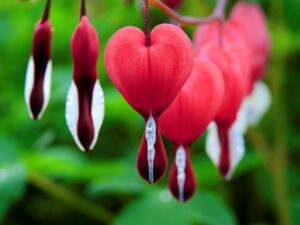Bleeding Heart
Overview
The Bleeding Heart plant, with its charming heart-shaped flowers, is a visual treat for shady garden corners. It’s a tenacious perennial that flourishes in partial shade and moist soil, blooming early and taking a summer rest when temperatures rise. While primarily ornamental, this plant’s beauty enhances any garden setting, demanding little but giving much in return with its striking blooms.

Characteristics
Known for its heart-shaped flowers, shade-loving nature, and early spring blooms.
Region
The Bleeding Heart plant is usually found or grown in temperate regions.
Natural Habitat
Found naturally in wooded areas and along forest floors.
Cultivation
Prefers partial shade, consistently moist soil, and thrives in neutral to slightly alkaline, humus-rich, well-draining soil.
Uses and Benefits
The Bleeding Heart plant, though not heralded for culinary or medicinal prowess, shines brightly as an ornamental addition to the garden. Its unique and romantic heart-shaped blossoms, coupled with its lush foliage, inject a splash of beauty into shady spots that may otherwise be neglected.
Gardening enthusiasts treasure these plants for their early spring bloom, which offers a symphony of flowers that can last for several weeks. The plant thrives in particular growing conditions—favoring the milder temperatures of spring before retreating into dormancy in the summer’s scorch. In the right conditions, Bleeding Hearts can be a hassle-free and utterly charming feature in a shaded garden nook5.

Cultivation Tips
To cultivate a thriving Bleeding Heart, start by choosing an appropriate spot that provides partial shade; a location that gets morning sun and is shaded in the afternoon is ideal. Your Bleeding Heart will adore moist, fertile, humus-rich soil. Ensure the soil is well-draining and aim for a neutral to slightly alkaline pH. In regions with cooler climates, planting in full sun is possible, provided the soil remains moist—this is key to keeping those distinct heart-shaped blooms happy.
Remember that Bleeding Hearts can be sensitive to the heat. To help them through warmer seasons, mulching can assist in keeping the roots cool and retaining soil moisture. Come midsummer, don’t be surprised if the plant decides it’s time to rest—the foliage often wilts and goes dormant in the heat4. Give your Bleeding Heart the care it needs early on, and you’ll be rewarded with a spectacular show of blooms in the spring to charm your garden[^1^] 2.
Seasonal Considerations
Bleeding Hearts grace us with their presence during the refreshingly cool early spring months, truly embracing the season’s start with their blooming. They eagerly make their appearance, sometimes even when patches of snow still claim the ground. As the temperature rises, they gradually begin to retreat. By the time the full force of summer’s warmth takes over, these plants typically enter dormancy. It’s a cycle that reminds us of the ebb and flow of seasons—Bleeding Hearts are a heartwarming signal that spring is here but also a gentle nudge to appreciate their beauty before the summer heat causes them to bid farewell3.
Therefore, for those wanting to enjoy these captivating blooms, it’s essential to get outside and relish their beauty in spring’s fleeting moments.

Issues and Troubleshooting
The love affair with the enchanting Bleeding Heart can be tested by its dislike for the heat. In warmer climates, you might find these sensitive plants struggling to establish themselves and could wilt under the strong sun4. To prevent a heartbreak, ensure your Bleeding Hearts are planted where they can enjoy the cooler embrace of part-shade—think of it as a sunscreen for plants.
If you notice a decline in your plant’s performance as the mercury rises, don’t fret. This is quite normal; Bleeding Hearts often take a summer nap, with their foliage yellowing and eventually going dormant in the heat of midsummer3. With proper care and a suitable location, your Bleeding Hearts will rebound, ready to charm you come next spring with their delightful blooms.
History and Folklore
Steeped in mystery and romance, the Bleeding Heart plant’s unique heart-shaped flowers have captivated many throughout history. This beloved botanical wonder, Lamprocapnos spectabilis, is often woven into tales of unrequited love and deep emotional bonds. According to legend, the flowers symbolize a love that is both deep and enduring, yet occasionally fraught with sorrow. Its intriguing appearance has also led it to be associated with more whimsical folklore, where each part of the flower represents an element of the story—a tale of love, compassion, and yet sometimes, heartache.
While specific historical anecdotes remain scarce, one can imagine the Bleeding Heart plant gracing the gardens of Victorian England, perhaps inspiring poets and lovers alike. This flowering gem seems to have sprung straight from the pages of a fairy tale, segueing seamlessly into our gardens as a reminder of nature’s capacity to mirror our deepest human emotions.
The absence of detailed historical records does little to diminish the allure that the Bleeding Heart holds in the realm of garden legends and botanical lore1.
References
1. Gardenia, “Bleeding Heart Flower: How to Grow and Care with Success,” https://www.gardenia.net/guide/how-to-grow-and-care-for-bleeding-heart
2. Better Homes & Gardens, “How to Plant and Grow Bleeding Heart,” https://www.bhg.com/gardening/plant-dictionary/perennial/bleeding-heart/
3. Almanac.com, “Bleeding Heart,” https://www.almanac.com/plant/bleeding-heart
4. The Spruce, “Bleeding Heart: Plant Care & Growing Guide,” https://www.thespruce.com/growing-bleeding-heart-plants-1402834
5. Gardenandhappy.com, “The Bleeding Heart Plant: An Essential Growing Guide,” https://gardenandhappy.com/bleeding-heart-plant/
Nicolas Duval
Nicolas is a passionate advocate for nature and the art of wildcrafting. His dedication shines through in Wildcraftia, a website he meticulously crafted to serve as a haven for nature enthusiasts worldwide. Driven by a deep appreciation for nature’s connection to humanity, Nicolas embarked on his journey in 2011 with SmokableHerbs, a platform showcasing his love for nature’s bounty. Building upon this foundation, he established Smokably, a thriving online store offering premium herbs and blends to a global audience.
